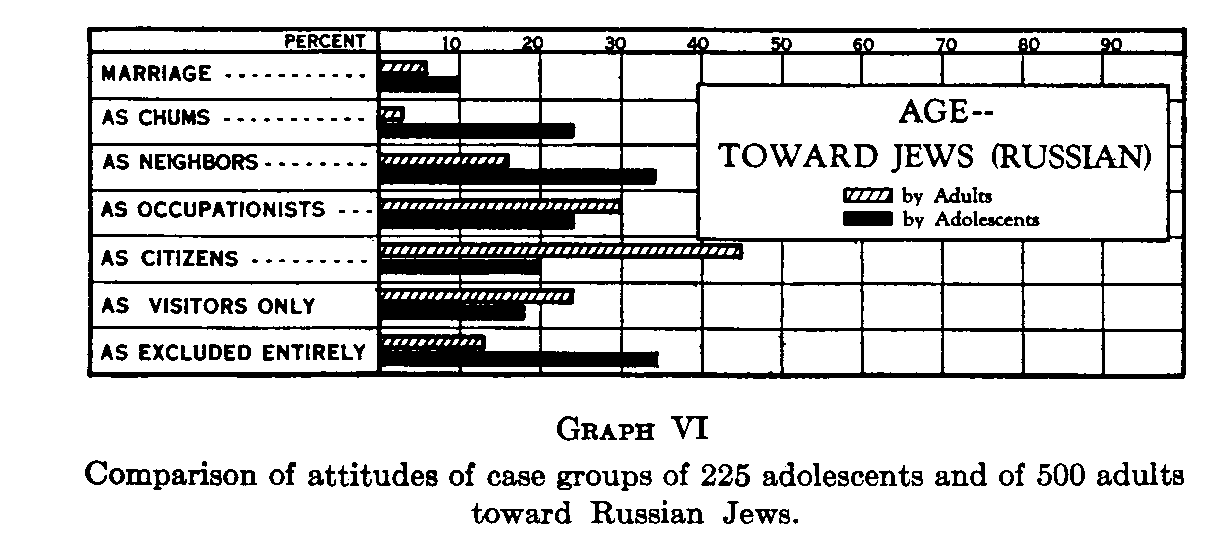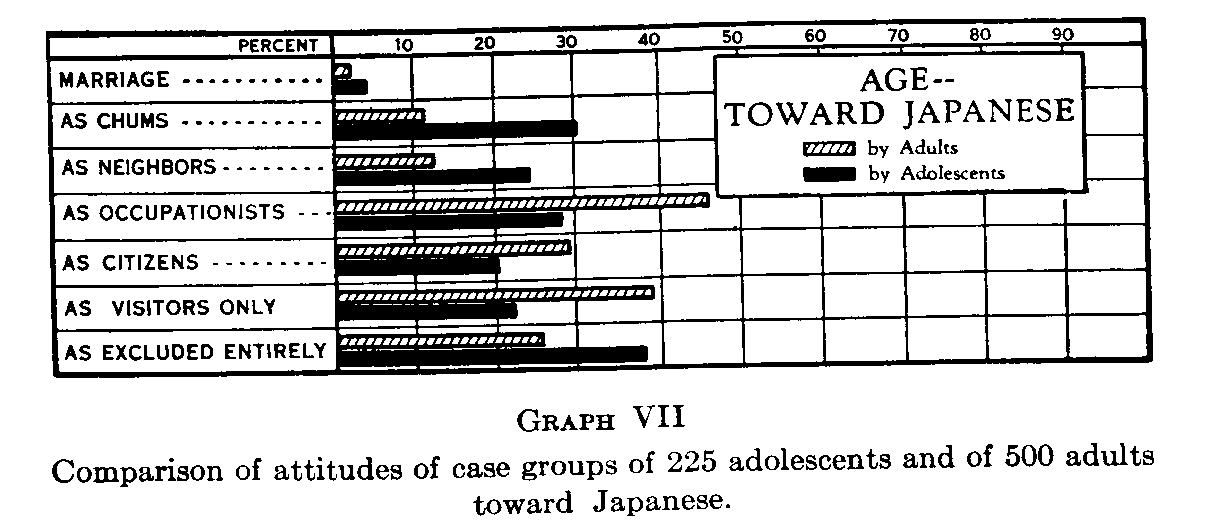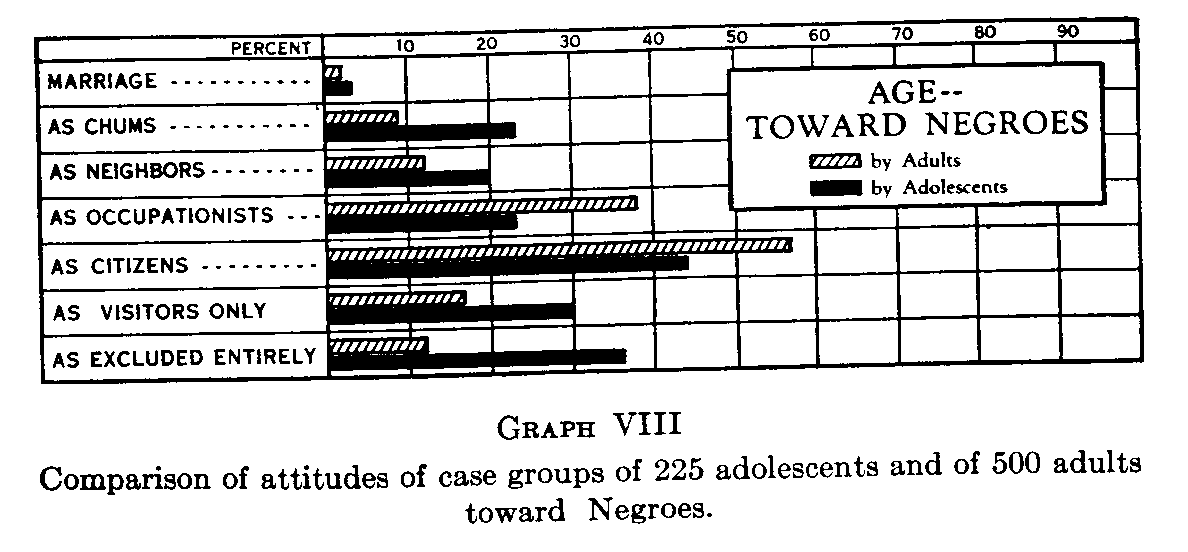Immigration and Race Attitudes
Chapter 13: Age Variations
Emory S. Bogardus
Table of Contents | Next | Previous
Children do not react at first to races, as such, but to persons. They first respond to others as individuals rather than as groups. The world is, to the child, a blurred theater of human beings irrespective of race, until he is told differently or until his experiences widen and he generalizes on his limited data. A small colored child does not as a rule discriminate against a white child unless he learns from his elders to do so, or unless he suffers adverse experiences.
97. As a child, my first recollections of races were entirely general. I used the terms " German," " Swede," and " Irish," long before they had any meaning except as a kind of second names for certain neighbors of ours in Iowa. Germany, Sweden, and Ireland had no meaning for me. I thought of Theodore, Andrew, and Eddie first, and then of their racial names. The one and only question in my mind was: What kind of a playmate is this boy or that? [1]
98. As a small boy, I liked to play with little children of any race. We lived for a time in a mixed neighborhood, one in transition. There were several races represented, even a few Negroes, and I played with all the children. The only exception was a little Italian boy, and I didn't like him because the teacher had to wash his head one day. The children in that family also had the scarlet fever, and that kept me away from them too.[2]
Aversions among children usually develop because of what may be called " personality clashes." They may arise between two white boys or between two colored boys, as well as between a white and a colored boy, for, at first each
( 175) new child who appears in a social situation is viewed as a strange individual and is judged on his own merits and demerits.
Personality clashes between children of different races may find various expressions. For instance, a very young child may cry with fear upon seeing a child of another race, apparently for the same reason that he cries when he sees a strange adult of his own race. An older child of a dominant nature may react variously to a " foreign " child, for example, by making fun of the latter, by tantalizing him, by taking his toys and keeping them - in fact, as he would toward a younger brother, but " more so."
An adolescent boy, particularly one in the " gang " stage, delights in tormenting a smaller boy whom he " does not like." With his own gang behind him, his tantalizing methods know no limits. A boy of foreign parentage, if his language, his clothes, or his actions be peculiar, is especially likely to be a victim. If the local community conditions be ripe, a fight between two youths of different races may " set off " a race conflagration.
99. Last night there was a fight down in front of one of the theaters on C. Street between the Negro and the white boys. It is rumored that they are going to finish it tonight; down there among the pipes they are going to have a regular gang fight. I (playground worker in the district) always try to watch out for that. Last night the members of each race called each other names although only boys took the part of their respective races. When a white boy recklessly called a Negro boy a dirty name, he little knew that he started a race riot. Did you see the big headlines in the extras today? This whole part of the city is stirred up, and it'll not be safe to go out on C. Street tonight.[3]
Unfriendly race attitudes of children toward children of immigrant races develop at various ages beginning at eight or younger. A western school principal, quoted by Bruno Lasker in The Inquiry, says that race hostility appears
( 176) among children from eight to twelve years old. " In the younger children I see no planned aversion, only what I think is a natural one. As the child gets older, the tendency to cruelty changes to ridicule, and unfairness becomes more subtle." These attitudes undergo changes, perhaps a progressive evolution " from one form of adverse race attitude into another." Mr Lasker concludes from studying a number of reports by school teachers and principals that " in the very young child an adverse race attitude usually takes the form of fear, that this later develops into hostility in which the element of fear gradually recedes and those of cruelty, patronage, unfairness and ridicule-in other words, the active elements of reaction, the attitude expressed in conduct-come to the front."
Friendly attitudes between children of different races also begin to develop naturally on the basis of personal rather than of race relations. The personal considerations outweigh the race factors when the latter are first mentioned and before the pressure of the child's own group opinion is felt.
100. The parents had been at the Christmas " assembly " at school proudly to watch five-year-old Johnny. It was natural that at dinner afterwards the celebration was discussed. One of them remarked on the fact that Henry, a classmate of John's of Jewish parentage, seemed to have enjoyed the singing of the hymns and a little religious address by one of the teachers quite as much as the Christian children. All at once John flared up, "Don't you call Henry a Jew - he is a friend of mine." [4]
Shifts to Racial Generalizations. -There soon comes a time in the child's life, in pre-adolescence, and certainly by the beginning of adolescence, depending on locality and culture conditions, when the child is likely to hear his parents speak against certain races. The poison arrows of prejudice and hatred find easy marks, An antipathy-
( 177) charged home atmosphere is naturally absorbed by the child, and he begins to make distinctions on race rather than on personal bases. Moreover, the racial distinctions do not arise out of his own experiences but from the generalizations of parents. When a white boy declares at home that he has made a new friend who is a colored boy, the ordinary white home promptly disapproves and reacts adversely to colored children as a race. An exception to this rule is so unusual that it seems astounding.
101. Toward the end of January, there was a discussion at the supper table one evening which involved some reference to colored people. The boy remarked quite casually, " My best friend .. . is a colored boy." No one of the household had known of this before. His mother said afterward that she realized that one smile, one exclamation, one surprised question, would have done more harm in instilling a consciousness of there being something unusual in the situation than hours of platitudes about its being very nice for him to have a little colored friend, etc., could have undone. She said that of the rather large household not one " quivered an eye-lid " or made the slightest sign of surprise, and the intimacy has continued to be spoken of in exactly the same way.[5]
In addition to the home there are the playmates who influence the child in his development of race antipathies, in changing from friendly personal judgments to adverse racial judgments. The influence of the child's playmates may be even greater in this direction than the influence of his parents, and equally unscientific.
102. A little white son of Ohio was visiting in a southern city. One day he was somewhat noisy in his play on the street, near a sanatorium for colored women. The Negro physician in charge came out and asked him to play less boisterously. Next day, the lad was again passing the place, this time accompanied by a little white southern boy. Both were shouting. Suddenly, the northern boy remembered the request of the physician. " We must be quiet," he said, " or well disturb the sick ladies in the hospital."
(178)
His companion was dumfounded. He stopped short, sat down on the curbstone, rested his check on his hand and assumed an air of the utmost disgust. " Say," he ejaculated, " you make me sick! Calling niggers ladies." [6]
103. My playmates made fun of me when they caught me talking to a colored girl one day at school. I used to walk part way home with two colored boys. They were so carefree and were fine boys. I liked their company, but I had to quit being seen in their company or else lose the respect of the white boys and especially of the white girls. To talk with them sometimes and to turn a cold shoulder at times when I was likely to be "seen" disturbed me, and I was forced to drop their acquaintance altogether. This was when I was about fourteen, I should say.[7]
The data at hand show that under certain conditions adolescents may express race antipathies more definitely than do adults. Many take their parents seriously and even enlarge upon the latter's reactions. Where the parents through religious beliefs or otherwise express a racial cosmopolitanism and an international idealism, the children will respond likewise, if there be good rapport between parents and their children. Oftentimes a community happening will demonstrate the responsiveness of children to the race antipathies of parents. In a junior high school on the Pacific Coast some years ago a capable and worthy Japanese boy was elected overwhelmingly as student-body president. Presently, within a few days, a recall against the newly elected Japanese was proposed, before he had had an opportunity to show what he could do. The recall plans spread throughout the school, and the children upon being questioned regarding their erratic action explained that when they had gone home and told how they had elected J. president, the parents had " blown up," asserting that "we don't want any Jap to be leading our children." The reponsiveness of the innocent children to their parents' strong race feeling(179) became so general that it had to be heeded by the school authorities.
Case-Group Studies. - In a regional study where children and adults from the southern states have moved to Los Angeles (where northern race attitudes prevail), the data show that nearly all the changes in attitudes toward the Negro on the part of the white people studied were among the young. Practically no change of attitude, certainly not of increased friendliness, was found among the older people.[8]
A study of white and colored boys shows that they may play together, and yet race distinctions may exist. The beginnings of a caste status may be developing. The two groups may play together in friendly ways, but with the tacit understanding that one is " superior " and the other " inferior."
Advance reports of the strike of fourteen hundred white boys and girls in Gary, Indiana, September, 1927, when twenty-four colored boys and girls were assigned to their school by the school authorities indicate that the strike was successful because the parents of the white young people stood more or less solidly behind the strike. Without parental encouragement and support the strike doubtless would have failed.
In a test case the racial attitudes of two hundred and twenty-five adolescents show interesting variations when compared with the race reactions of adults. Graph V indicates, for instance, that the given adolescents are less friendly toward Germans. Interviewing brings out the fact that the adolescents are still laboring under the influence of anti-German talk that they heard in 1918 when they were small children. The stories of German atrocities, such as mutilation of children, made a vivid and lasting impression. The more friendly attitudes toward Germans
(
180) that the American adults now express is due to rationalization upon the
war and postwar conditions. This rationalization has not affected their children
to the same degree, at least not sufficiently to enable them to overcome the
emotionally vivid reactions of early childhood.

Graphs VI, VII, and VIII indicate other definite tendencies. The adolescents
are more friendly toward the Jews, Japanese, and Negroes than are the adults in
primary group relationships (notice columns 2 and 3) and less friendly in the
larger and more impersonal group relationships. Adolescents react chiefly in
terms of primary groups.
The mature and aged react racially in either one of two ways. They easily grow
confirmed in their race prejudices. These fixations are exceedingly difficult to
change, and their nature is indicated by such expressions: " You never can trust
the Irish "; " once a Jap always a Jap "; " the nigger can't change his skin."


104. I'm beyond the allotted three score and ten and still hate the Turks and always shall. I never could trust them as a race. Their persecution of Christian Armenians, their religion, their harems, their repulsive customs and habits - oh, why go over their deceitful ways further? There's no use arguing with me, not a bit - the more you talk, the more time you are wasting on me. When I get to Heaven, I hope there will be no Turks there.[9]
( 181)
The second reaction type is one of mellowed friendship. As a person grows older he views life in a new perspective; a more universal and perhaps theoretical oneness of life develops. Race distinctions recede. Life ends as it begins, in reactions to persons rather than to larger group units.
105. I see things in a bigger way than I once did. There was a time when I despised the Japs, because I thought that some day Japan might eclipse the United States; but I now say, let the best race win. That is a strange statement for me to make, I know, but I have thought it all through and mean it. Of course, I still think that Americans are the ablest people on earth, and so perhaps I'm not as generous as I sound; and yet if the Americans sink low and become mere gluttons, then let some better race take their place. Perhaps it will be the Chinese. Who can tell? [10]
As practical daily contacts grow fewer, prejudices either remain fixed, or mellowed philosophizing develops. The determination of which of these two tendencies will develop depends on temperament, previous race experiences, and philosophy of life.Racial reactions run an age gamut. At first they are individual, not racial at all. Then parents and playmates introduce racial generalizations. Parental antipathies play a large rôle. Idealistic attitudes may be encouraged in college days. Later, in middle life, a practical viewpoint based on occupational experiences, often of a competitive nature, develops. Antipathies easily become fixed. Old age sees a continuation of antipathy fixations, or else mellowed reflections of broad tolerance.
PROJECTS
1. Write out in detail your first recollections of races besides your own, drawing comparisons. What races were viewed favorably, which unfavorably, at what ages, under what conditions, and accompanied by what personal experiences?
( 182)
2. Trace your own reactions by age periods concerning any three selected races.
3. Make a first-hand study of the circumstances under which native children react favorably and unfavorably to immigrant children.
4. Make a similar study concerning the race reactions of immigrant children toward " native " children.
5. Describe from observation and analyze the different kinds of social situations in which children of different races in your community are in contact.
6. Describe the social situations in which children manifest racial reactions of (a) fear, (b) hatred, (c) cruelty, (d) unfairness, (e) patronizing attitude, and (f) ridicule.
AGE VARIATIONS
ABBOTT, EDITH, Immigration, pp. 468-473. University of Chicago Press, 1924.
BRECKINRINGE, S. P., New Homes for Old, Chaps. II, VI. Harper.
HASKIN, FREDERICK, The Immigrant, Chaps. XVII, XX. Revell, 1913.
Reports of the Immigration Commission, Vols. XXIX-XXXIII. Washington, 1911.
SMITH, W. C., " The Second Generation Oriental-American," Jour. of Applied Sociology, Vol. X, pp. 160-168.
THOMAS, W. I., AND ZNANIECKI, F., The Polish Peasant in Europe and America, Vol. V, pp. 294-339. Badger, 1920.